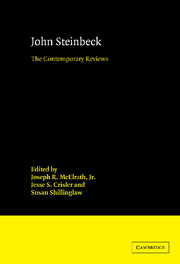Book contents
- Frontmatter
- Contents
- Series Editor's Preface
- Introduction
- 1 Cup of Gold (1929)
- 2 The Pastures of Heaven (1932)
- 3 To a God Unknown (1933)
- 4 Tortilla Flat (1935)
- 5 In Dubious Battle (1936)
- 6 Of Mice and Men (the novel, 1937)
- 7 The Red Pony (1937)
- 8 Of Mice and Men (the play, 1937)
- 9 The Long Valley (1938)
- 10 The Grapes of Wrath (1939)
- 11 The Forgotten Village (1941)
- 12 Sea of Cortez (1941)
- 13 The Moon Is Down (the novel, 1942)
- 14 The Moon Is Down (the play, 1942)
- 15 Bombs Away (1942)
- 16 Cannery Row (1945)
- 17 The Wayward Bus (1947)
- 18 The Pearl (1947)
- 19 A Russian Journal (1948)
- 20 Burning Bright (the novel, 1950)
- 21 Burning Bright (the play, 1950)
- 22 The Log from the Sea of Cortez (1951)
- 23 East of Eden (1952)
- 24 Sweet Thursday (1954)
- 25 The Short Reign of Pippin IV (1957)
- 26 Once There Was a War (1958)
- 27 The Winter of Our Discontent (1961)
- 28 Travels with Charley in Search of America (1962)
- 29 America and Americans (1966)
- 30 Journal of a Novel: The East of Eden Letters (1969)
- 31 The Acts of King Arthur and His Noble Knights (1976)
- 32 Working Days: The Journals of The Grapes of Wrath 1938–1941 (1989)
- Index
11 - The Forgotten Village (1941)
Published online by Cambridge University Press: 03 May 2010
- Frontmatter
- Contents
- Series Editor's Preface
- Introduction
- 1 Cup of Gold (1929)
- 2 The Pastures of Heaven (1932)
- 3 To a God Unknown (1933)
- 4 Tortilla Flat (1935)
- 5 In Dubious Battle (1936)
- 6 Of Mice and Men (the novel, 1937)
- 7 The Red Pony (1937)
- 8 Of Mice and Men (the play, 1937)
- 9 The Long Valley (1938)
- 10 The Grapes of Wrath (1939)
- 11 The Forgotten Village (1941)
- 12 Sea of Cortez (1941)
- 13 The Moon Is Down (the novel, 1942)
- 14 The Moon Is Down (the play, 1942)
- 15 Bombs Away (1942)
- 16 Cannery Row (1945)
- 17 The Wayward Bus (1947)
- 18 The Pearl (1947)
- 19 A Russian Journal (1948)
- 20 Burning Bright (the novel, 1950)
- 21 Burning Bright (the play, 1950)
- 22 The Log from the Sea of Cortez (1951)
- 23 East of Eden (1952)
- 24 Sweet Thursday (1954)
- 25 The Short Reign of Pippin IV (1957)
- 26 Once There Was a War (1958)
- 27 The Winter of Our Discontent (1961)
- 28 Travels with Charley in Search of America (1962)
- 29 America and Americans (1966)
- 30 Journal of a Novel: The East of Eden Letters (1969)
- 31 The Acts of King Arthur and His Noble Knights (1976)
- 32 Working Days: The Journals of The Grapes of Wrath 1938–1941 (1989)
- Index
Summary
Ralph Thompson.
“Books of the Times.”
New York Times,
26 May 1941, p. 17.
… The Forgotten Village is… graphic, being in fact 95 per cent stills from a forthcoming documentary film made in Mexico by Herbert Kline, Alexander Hackensmid and associates.
It seems that Mr. Steinbeck wrote the story before anything else was done, and that Mr. Kline (who produced Crisis and Lights Out in Europe) and a camera crew then went down across the border, found a village to suit the purposes of the script, and began taking pictures. The film is to be released this Autumn, and if it is half as effective on the screen as The Forgotten Village is in print, it will be the finest thing of its kind since Eisenstein's Thunder Over Mexico.
Magnificent as it was, the Eisenstein had no particular continuity, or at any rate didn't have much of any by the time it was shown to the public. This one will be almost wholly “story,” with the socalled documentary detail minor rather than major, and flag-waving and political speech-making left out altogether. In a broad sense, the story is that of Ibsen's Enemy of the People retold in terms of the Mexican peon. Specifically, it is an account of a dramatic clash between medical superstition and medical science in an isolated mountain town.
Mr. Steinbeck's sympathetic text runs but a few lines to the page, and serves as captions for the pictures, of which there are 136 in all, reproduced in photogravure.
- Type
- Chapter
- Information
- John SteinbeckThe Contemporary Reviews, pp. 193 - 200Publisher: Cambridge University PressPrint publication year: 1996



